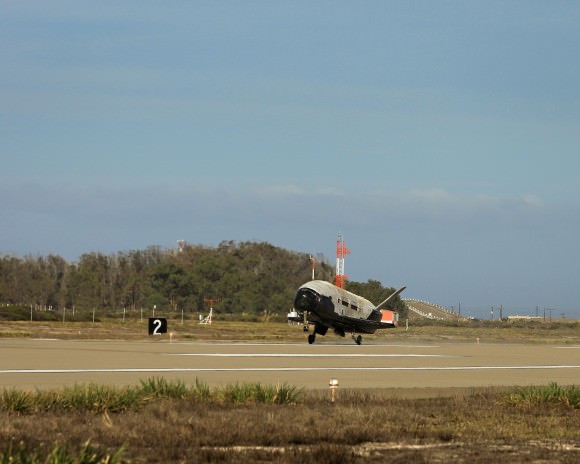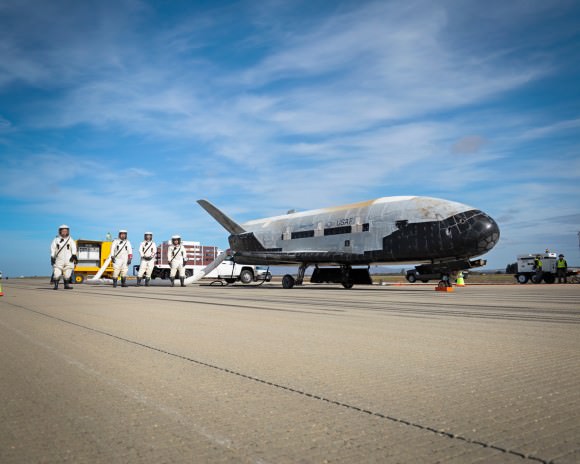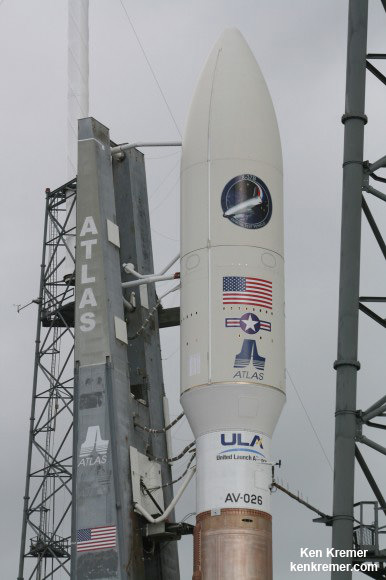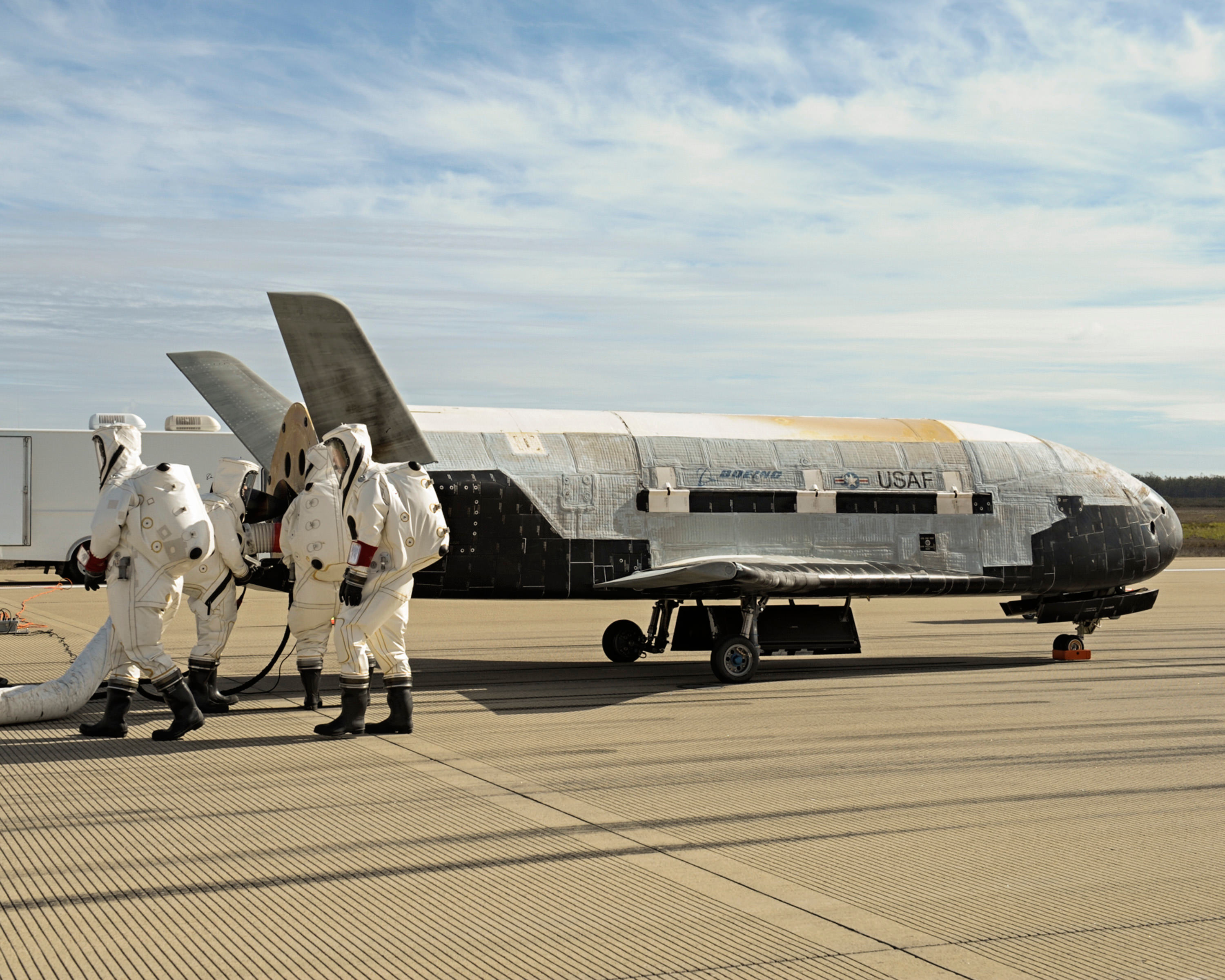Recovery crew members process the X-37B Orbital Test Vehicle at Vandenberg Air Force Base after completing 674 days in space. A total of three X-37B missions have been completed, totaling 1,367 days on orbit. Photo: Boeing
Watch cool landing video below[/caption]
The US Air Force’s unmanned, X-37B military space plane made an autonomous runway landing on Friday, Oct. 17, at Vandenberg Air Force Base, Calif., concluding an orbital test flight nearly two years in duration on a record breaking mission whose goals are shrouded in secrecy.
The Boeing-built X-37B, also known as the Orbital Test Vehicle (OTV), successfully fired its baking thrusters, plunged through the atmosphere, endured scorching re-entry heating and safely rolled to touch down on Vandenberg Air Force Base at 9:24 a.m. PDT Friday, concluding a clandestine 674-day experimental test mission for the U.S. Air Force Rapid Capabilities Office.
This was the third flight of an X-37B OTV vehicle on a mission known as OTV-3.
“I’m extremely proud of our team for coming together to execute this third safe and successful landing,” said Col Keith Balts, 30th Space Wing commander, in a statement.
“Everyone from our on console space operators to our airfield managers and civil engineers take pride in this unique mission and exemplify excellence during its execution.”
Nothing is known about the flights objectives or accomplishments beyond testing the vehicle itself.
The OTV is somewhat like a miniature version of NASA’s space shuttles. Boeing has built two OTV vehicles.
The reusable space plane is designed to be launched like a satellite and land on a runway like an airplane and a NASA space shuttle. The X-37B is one of the newest and most advanced reentry spacecraft.

OTV-3 also marked the first reflight of an OTV vehicle, to test its re-usability.
The OTV-3 mission was launched from Cape Canaveral Air Force Station, Fla., on Dec. 11, 2012, encapsulated inside the payload fairing atop a United Launch Alliance Atlas V rocket from Space Launch Complex 41.
Among the primary mission goals of the first two flights were check outs of the vehicles capabilities and reentry systems and testing the ability to send experiments to space and return them safely.
It is not known if the X-37B conducted reconnaissance activities during the test flights. It does have the capability to deploy satellites in space.
All three OTV missions have launched from Cape Canaveral and landed at Vandenberg.
The first OTV mission launched on April 22, 2010, and concluded on Dec. 3, 2010, after 224 days in orbit. The second OTV mission began March 5, 2011, and concluded on June 16, 2012, after 468 days on orbit.
Here’s a video of the OTV-3 landing:
Video Caption: The X-37B Orbital Test Vehicle mission 3 (OTV-3), the Air Force’s unmanned, reusable space plane, landed at Vandenberg Air Force Base at 9:24 a.m. Oct. 17. Credit: USAF
“The 30th Space Wing and our mission partners, Air Force Rapid Capabilities Office, Boeing, and our base support contractors, have put countless hours of hard work into preparing for this landing and today we were able to see the culmination of that dedication,” said Balts.
The 11,000 pound state-of -the art reusable OTV space plane was built by Boeing and is about a quarter the size of a NASA space shuttle. It was originally developed by NASA but was transferred to the Defense Advanced Research Projects Agency (DARPA) in 2004.
Altogether, the OTV vehicles have spent 1,334 days in Earth orbit.
The OTV’s can stay on orbit far longer than NASA’s shuttles since their power is supplemented by solar panels deployed from the vehicles open cargo bay.
“The landing of OTV-3 marks a hallmark event for the program” said the X-37B program manager. “The mission is our longest to date and we’re pleased with the incremental progress we’ve seen in our testing of the reusable space plane. The dedication and hard work by the entire team has made us extremely proud.”
“With a program total of 1,367 days on orbit over three missions, these agile and powerful small space vehicles have completed more days on orbit than all 135 Space Shuttle missions combined, which total 1,334 days,” said Ken Torok, Boeing director of Experimental Systems, in a statement.

“The X-37B is the newest and most advanced re-entry spacecraft. Managed by the Air Force Rapid Capabilities Office, the X-37B program performs risk reduction, experimentation and concept of operations development for reusable space vehicle technologies,” according to an Air Force statement.
The Air Force says that the next X-37B launch on the OTV-4 mission is due to liftoff from Cape Canaveral sometime in 2015.
Stay tuned here for Ken’s continuing Earth and Planetary science and human spaceflight news.



why the hazmat suits? I cannot imagine the craft needs protection after surviving launch, 2 years in orbit and re-entry. So? Plutonium dust from destroyed Soviet, er, Russian, spy satellites? Andromeda Strain? What? Any ideas anyone?
The hazmat suits are probably for the crew’s protection, not the craft’s. I’d guess hydrazine from the propulsion/maneuvering engines and that (or something else noxious) from auxiliary power unit fuel.
Thank you. I hadn’t considered propulsion. In fact I would have thought they’d land dry for safety’s sake.
Seeing how “Thoroughly cleaning the latest Mars rover, Curiosity, cost $10 million … and 150,000 heat-resistent microbes hitched a ride on curiosity” (Discover Magazine Nov 14) anyways; I would guess that they would suspect that microbes ‘out there’ could hitch a ride here, on the space shuttle.
There is a reason NASA cost $2 billion whether Shuttle launched or not.
I Haven’t read the Discovery mag article you are trying to quote, but I am certain you have some facts wrong. First … we (Earth humans) are not aware of ANY life forms not originating from Earth, so there are no “heat resistant microbes” from space! Second, Curiosity is still on Mars, so who is cleaning it hear on Earth?
I am reasonably curtain the article refers to the cleaning of Curiosity BEFORE it left Earth so we don’t contaminate Mars with “heat resistant microbes” for Earth.
Any Microbe or any other life form from space would be the biggest news to hit humanity since the last ice age.
Just saying!
Nearly two years is about the same length of time it would take to get to Mars or Phobos and back. Got mail? OR – go out to one of the Lagrange/Trojan points and take a closer look at that weird asteroid? Yes.. it IS metallic…
I wish that the military space program became civilian and public. I don’t think that anyone can claim that the US military has been successful, despite its huge costs and fancy stuff like this. Has this spacecraft been spying on an analphabetic beduin in a desert? Come on!
One certainly hopes every Beduin and her camel, from Marrakesh to Timbuktu to Ankara to Mumbai has been photographed, tracked and back tracked. Yes.
Baking thrusters?
The sound really surprised me–always thought the sound from a landing airplane was a product of propulsion.
And man that thing was screaming!
Must we get worried that these kind of missions NASA is doing can bring dangerous microbes on Earth?
Sure. Be prepared for sharknados with SpaceEbola. We all gonna die!!11!
I like that, SpaceEbola, wow! wiping out all mankind.